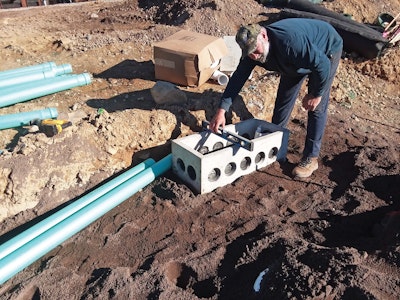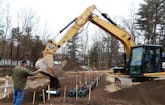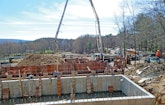
Workers install White Knight WK-200 Microbial Inoculator Generator towers through the septic tank risers. Black boxes house the turbine fans, while the biofilter is to the right. (Photos courtesy of Onsite Engineering)
During the 2018 summer season, wastewater ponding at the toe of a drainfield alerted the owner of a nonprofit girls camp in Kerhonkson, New York, to a serious problem. The Ulster County Health Department closed the 49,400-gpd system and mandated the wastewater be pumped. The expense was a hardship for a camp funded mainly by donations.
The camp owner hired Eric Murdock, P.E., proprietor of Onsite Engineering in Syracuse, to upgrade the legacy system. The company specializes in designing systems with small footprints.
“In one day, the camp goes from empty to full occupancy for two months — July and August,” Murdock says. “It’s a huge campus with dozens of cabins and buildings accommodating some 1,500 weekly campers plus staff.”
In January 2019, Murdock determined the breakout was caused by groundwater infiltrating the septic tanks and overloading the system. Poor site conditions limited his design options to using the existing 180-by-180-square-foot drainfield for the replacement.
“There was no room for error, so I overengineered the design to ensure a lifetime of trouble-free operation and compliance with the New York’s State Pollutant Discharge Elimination System permit,” Murdock says. His safety net included:
- A loading rate of 1.5 gpd per square foot instead of the manufacturer’s recommended loading rate of 2.25 gpd per square foot
- 108,000 gallons of additional tankage supplementing the existing 41,000 gallons of tankage
- Pretreatment
- 2,996-gallon doses instead of the recommended 8,325 gallons
- Gravity dosing to circumvent power outages
The trick was to complete the permitting and installation in time for the camp’s summer season in six months.
Site conditions
Soils are clay loam with shallow depth to bedrock. The percolation rate at the bottom of the existing trenches (48 inches) is 30 minutes per inch.
System components
Murdock designed the system to treat 49,400 gpd. Major components are:
- 36,000-gallon cast-in-place flow equalization tank
- Two 36,000-gallon cast-in-place septic tanks
- 28 White Knight WK-200 Microbial Inoculator Generator towers (Knight Treatment Systems)
- Seven HP-200 linear air pumps (Hiblow USA)
- 11,220-gallon cast-in-place dose tank
- Multiple-outlet Flout chamber with Alternator system (Rissy Plastics)
- Model DC3 data logger (Rissy Plastics)
- 16,650 feet of 12-inch Presby Advanced Enviro-Septic treatment-dispersal pipe (Infiltrator Water Technologies)
- 10 RP145c turbine fans (RadonAway)
- 48 Quick4 Equalizer 36 chambers (Infiltrator Water Technologies)
System operation
After wastewater passes through the camp’s original tankage, on-demand pumps in the existing 6,000-gallon dose tank send effluent to the equalization tank in the new central treatment area. Liquid then gravity-flows through the process tanks to the dose tank. The dose tank and process tanks have 8, 10 and 10 towers, respectively, each with four microbial breeding columns and a 0.75-inch feeder line delivering air to the fine-bubble diffuser at the base.
In the dose tank, a Flout with 10 3-inch outlet tubes and flow control discs delivers water to dedicated distribution boxes, five per side of the mirror-image drainfield. Eight times per day, the two zones are alternately dosed with 2,996 gallons at 120 gpm.
Ball valves evenly distribute the liquid to 37 modules per zone. Each module has three 75-foot-long treatment pipes. The first two dispersal areas closest to the dose tank have eight modules; the three other sections have seven modules. The data logger counts the cycles and potable water usage.
In-line turbine fans connected to 4-inch PVC piping convey vapors from the tank risers to a 111-by-13-foot-wide biofilter. The venting bed has four sections of paired chambers, six per side. Each section has a dedicated fan that draws vapors into a 4-inch perforated pipe at the bottom of the chambers. As the vapors diffuse up through 36 inches of wood chips, they trap odor-laden moisture and purify the air.
An 8-by-10-foot shed shelters the fans, air pumps and electric service.
Installation
In early April, installing the drainfield and tanks began simultaneously. Gary Royce Jr., owner of A+ Excavating in Fulton, was the installer and construction manager. Hudson Valley Concrete Pumping did the pours.
In the camp, Bill French from Onsite Engineering supervised testing the septic tanks for watertightness and replacing the 20 tanks that failed with 1,500-gallon tanks. Workers also replaced leaking building sewers and portions of the force main, and they built curtain drains to divert major runoff from tanks in low areas.
Meanwhile, Royce’s heavy-equipment operators excavated the L-shaped hole for the three 36,000-gallon tanks (64 by 18 by 8 feet high) and dose tank (27 by 14 by 7 feet high), then bedded the area with 12 inches of washed broken stone. “We lucked out,” Murdock says. “We didn’t hit bedrock and the soil was stable.”
As additional workers finished a form for the 12-inch-thick tank floors, Hudson Valley Concrete Pumping arrived with a Putzmeister boom pump to fill it. Multiple trucks from Sullivan Structures, a ready mix supplier, fed the pump. They repeated the procedure for the 12-inch-thick tank walls, completing four walls in a single pour. Each pour took 28 days to cure. The lids with penetrations for the 24-inch risers (Polylok) were poured in place.
Simultaneously, Royce’s operators removed the top 48 inches of the existing drainfield and filled in the toe of the downgradient slope with the spoils. Then workers leveled off 36 inches of regular sand on the field, followed by 6 inches of system sand (ASTM C33 concrete sand).
“Organization enabled the installation to go smoothly,” Murdock says. “We moved material once to minimize traffic. End dump trailers delivered sand and gravel to the drop zone, then wheel loaders loaded the crawler carriers for delivery to the appropriate work site.”
Methodical planning prevented workers and machines from obstructing one another. Some equipment included Komatsu 39EX bulldozers, Caterpillar 304E excavators and mini-excavators, John Deere crawler dozers, Bobcat S130 skid-steers and Toolcat 5600 utility work machines, Komatsu WA180 wheel loaders and Terramac RT9 crawler carriers.
Expert help
Because Royce’s team had never installed a Presby system covering 32,000 square feet, company representative Mike Carbonneau worked with them for three days to ensure success.
“They set grade stakes, which helped hold the piping 18 inches on center, then built up 6 inches of system sand around and over the pipes,” French says. “Excavators placed the material, but we leveled it.” System sand also extended 5 feet from both ends of the pipes. As each dispersal area was completed, it was covered with 12 inches of topsoil. Installation took a month.
“Meticulous organization also enabled us to take advantage of good weather early in the project and get ahead of schedule,” Murdock says. “This helped immensely because we weren’t forced to work in the rain.”
Additional help came from Jim Richard, inventor of the Flout. “Because we needed 10 outlet tubes and only six had been used so far, Jim helped design and install the device,” Murdock says. “It’s simple, it works, and it provides dosing solutions that weren’t possible before.”
Flouts are open plastic boxes with an attached weight and outlet pipes. As effluent accumulates in the tank, the box floats. At maximum depth, effluent spills into the box, sinking it and opening the outlets to the distribution boxes. Once the tank is empty, the cycle resets.
Pretreatment
To install the microbial inoculator generators, workers lowered the columns via tethers through the risers to the floor of the tanks. At the base of the risers, they connected each column’s flexible hose to the air supply line delivering 2.25 cfm at 2 psi. After filling the tanks to operating level, workers inoculated the breeding columns with the IOS-500 bacterial matrix.
“The greater the depth, the more efficient fine-bubble diffusion becomes because of increased oxygen uptake,” Murdock says. “A high volume of air isn’t necessary.” It took less that 15 minutes to install each tower, and building the bark bed biofilter was straightforward. The project concluded at the end of June.
Maintenance
The New York’s State Pollutant Discharge Elimination System permit requires monthly visits during the operating season to collect samples from the tanks. Onsite Engineering does this and system startup, which includes running the fans and air pumps, adjusting the airflow for bubble size and hosing off the microbial inoculators.
“We also collect samples from a groundwater monitoring well downgrade of the system to demonstrate compliance,” Murdock says. “At the end of the season, the owner shuts off the power and goes home.”










